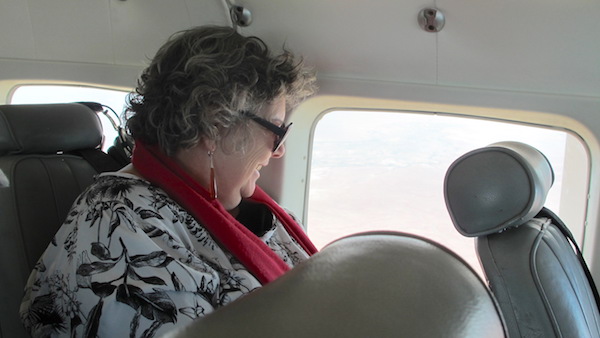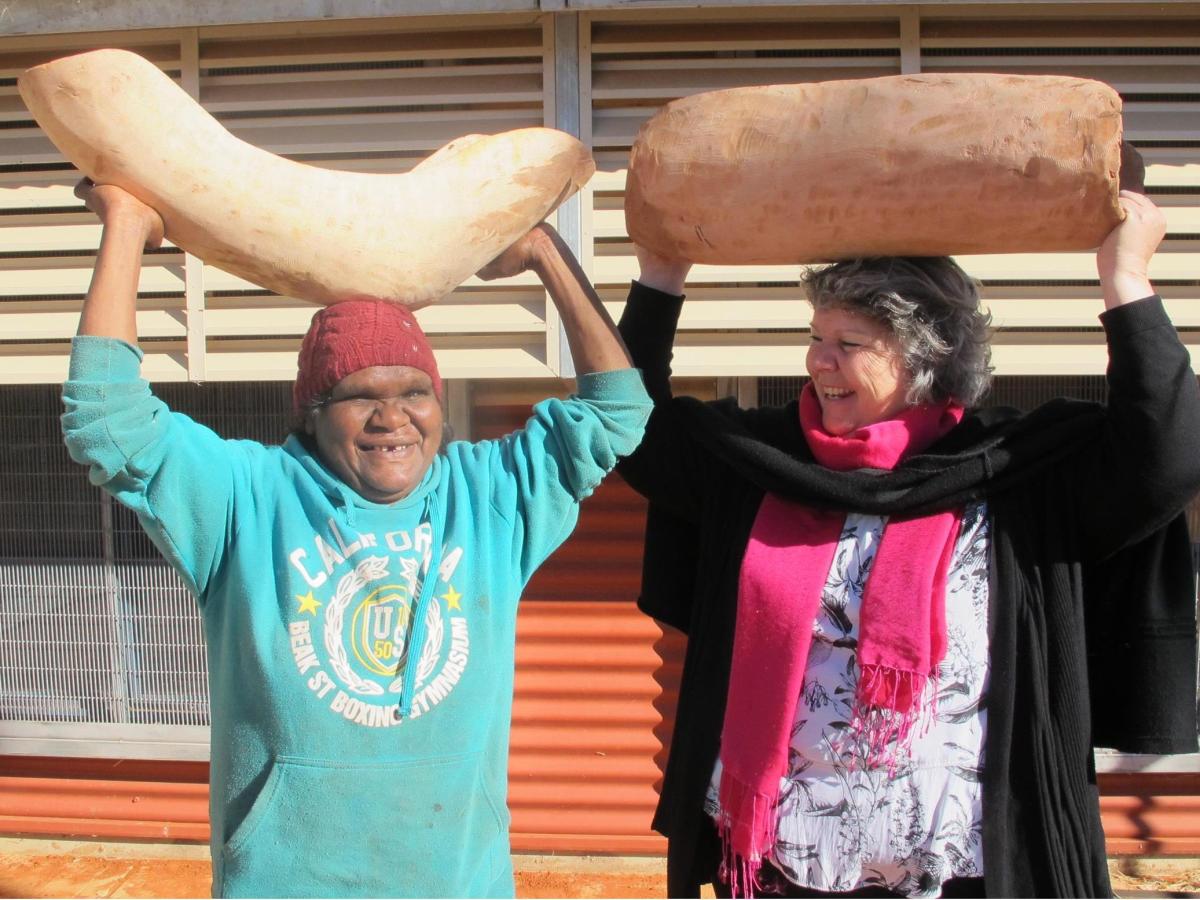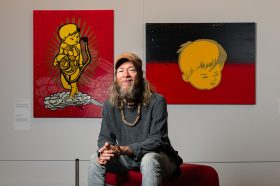Nici Cumpston is inspired by visiting country and working with artists in community, such as here at Mimili Arts in APY Lands; Photo ArtsHub.
In 2015, Adelaide – a city renowned for its perennial events, drawing some 52,000 tourists annually through existing events – welcomed a new festival. A report released last February confirmed that the economic impact of Adelaide’s combined 10 major arts festivals was about $74.7 million or 1,062,000 tickets.
Getting Tarnanthi right, then, is vital.
The inaugural Tarnanthi, a festival of Aboriginal and Torres Strait Islander art, was a great success. So much so that last November, mining giant BHP Billiton, in partnership with the State Government of South Australia, decided to throw $17.54 million at the biennial festival to ensure its delivery for the next five years.
At the time, Art Gallery of South Australia (AGSA) director Nick Mitzevich told ArtsHub: ‘Once in every 10 or 15 years there’s a project that has the capacity to transform the cultural sector. This is one of those projects.’
Read: Big boost for Indigenous arts
From 13 – 22 October 2017 Tarnanthi will return, and the art world and culture scouts are keenly watching to see how that money will make a difference.
ArtsHub caught up with AGSA Curator of Aboriginal and Torres Strait Islander Art, and lead Artistic Director of the Tarnanthi Festival, Nici Cumpston, on a remote tarmac in the APY Lands during a two-day visit to Country.
Read: Working on Country – what does it mean?
Cumpston said the support from BHP has enabled her to work with artists to create bigger projects than she would otherwise have been unable to realise.
‘The way that I have worked is ask people what are their ideas; what are they working on and how can we help support them going forward to present that body of work. Can we help them to make something more ambitious?,’ said Cumpston.
She added that having a five-year plan works well, ensuring projects are not rolled out prematurely. Artists can ‘hold off’ to allow them the time to really develop ideas.
While that injection of funding has had a timing implication for Tarnanthi from the back end – not rushing its curatorial vision and allowing those stories to amplified from a ground roots level – there is another conversation about timing that is pertinent to Tarnanthi’s return in 2017.
This year marks the 50th anniversary of the 1967 Federal Referendum to determine references to Aboriginal people in the Australian Constitution, and the 20th anniversary of the landmark ‘Bringing them Home’ Report‘s tabling in Federal Parliament, which recognised the Stolen Generations.
It is again curious timing that we are reminded these stories are ever present, and unresolved.
A recent example is that of APY Lands artist Betty Kuntiwa Pumani, whose painting Antara won the 2017 Wynne Prize, only for its be criticised by a senior (white male) Australian artist as not having a ‘sense of place’.
ArtsHub viewed Antara in the studio before it headed to Sydney. The painting depicts the country of Betty’s mother, the late painter Kunmanara (Milatjari) Pumani. Betty and her older sister Ngupulya, also a finalist in the Wynne Prize, are now custodians of the land.
We are publishing this story on the eve of tonight’s announcement of the Telstra Award (National Aboriginal and Torres Strait Islander Art Award), which has helped define place over the past 34 years and has an increasingly political voice.
These Awards have become important platforms – along with regional Indigenous art fairs and Tarnanthi – that build understanding, knowledge and tolerance.
Cumpston said: ‘What I have been able to see and learn is that people are sharing the history of place and absolutely those stories are political.
‘How they are trying to cope with different situations and how they are moving forward – they are strong stories – and they are by people who have ultimately fought to gain recognition of their country.
‘They are very political people but in a soft gentle way, and the works we are seeing now are enabling us to learn that history and understand it more fully and that is the way forward for us as a nation, to understand these very important stories and how lucky of we are that it is through works of art. That is the way to go forward with race relations in this country.’

Flying over APY Lands in remote South Australia, Tarnanthi Artistic Director Nici Cumpston; Photo ArtsHub
Tarnanthi offers learnings for us all
The gently spoken Cumpston is equally respected in both city and country.
She said: ‘I think one of the main things that I learnt from the first edition of Tarnanthi was the importance for the artists to participate in the actual event, to be able to see their work – to be proud of what they have done.
‘Most important, however, is for them to have the chance to come to Adelaide and have the time to look at everybody else’s work and meet the other artists.’
She said that the interim two years have been a period of gestation, where projects and ideas have been simmering away.
‘I definitely think it’s given them “permission” to be a bit more confident, a bit bolder by seeing Tarnanthi and how their works were realised within space at the gallery or partner venues; they know what to expect in terms of how the works look and so have been able to take the work to another level, I believe.’
Cumpston confirmed that, like the first edition of Tarnanthi there will be a variety of works with a few stand alone moments focusing on independent artists and art centres. The festival and its partner art fair will showcase over 1,000 artists.
One of those focus areas will be the seven art centres from the Anangu Pitjantjatjara Yankunytjatjara Lands in South Australia – Ernabella Arts, Tjala Arts, Mimili Maku Arts, Iwantja Arts, Tjungu Palya, Kaltijti Arts and Ninuku Arts.
Forty five artists have come together to paint two monumental collaborative paintings, which will be accompanied by Robert Fielding’s black and white photographs of the artists.

Nici Cumpston with Pepai Jangala Carroll; Photo Artshub
Mumu Mike Williams’ paintings on two repurposed canvas mailbags will be suspended by a kulata (spear); senior painter and ceramicist Pepai Jangala Carroll with join fell Ernabella artist and potter Derek Jungarrayi Thompson for an exhibition titled Mark and Membory, follow a recent pilgrimage by the pair to their ancestral homelands.
From Alice Springs the artists at Yarrenyty Arltere will showcase Kulila, a group of embroided soft sculptures which are self-portraits of the artists; and Maningrida artists, husband and wife Bob Burrawal and Lena Yarinkura are creating an immersive multimedia installation.
Check the Tarnanthi website for projects as they are unveiled.
Cumpston finished: ‘The people inspire me no end. I feel so honoured to be welcomed into these communities and to do my utmost to share their stories in the clearest way possible. It’s invigorating and enriching.’
Tarnanthi will be presented 13 October 2017 – 28 January 2018 at the Art Gallery of South Australia and other venues across Adelaide. The Festival is complemented by an art fair at Tandanya (13-15 October) that will showcase and sell the work from remote art centres, including those from APY Lands.
Gina Fairley travelled to APY Lands courtesy of South Australian Tourism Commission and the Art Gallery of South Australia.





